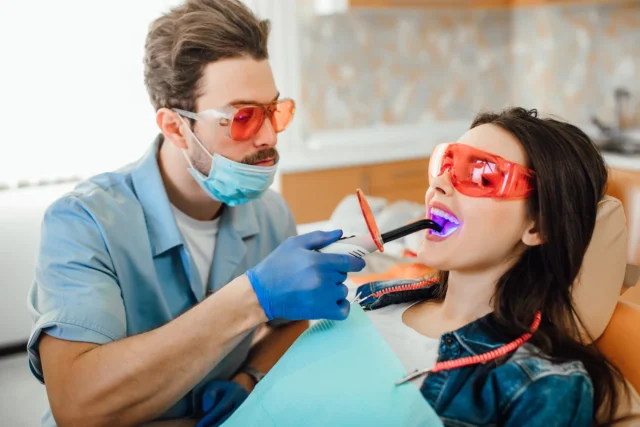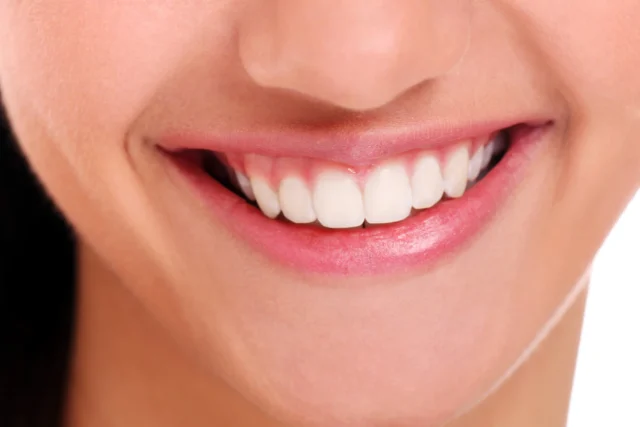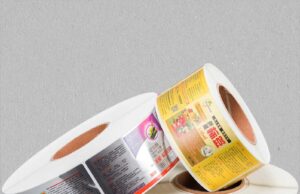
Teeth whitening is a popular cosmetic dental procedure used to improve the appearance of teeth by removing stains, plaque, and other discoloration. Professional tooth whitening can be done through your dentist’s office by using bleaching agents or lasers. However, not all treatments are the same— some may last longer than others.
Depending on the type of treatment you choose and how much staining or discoloration you want to remove, the results may last for several months or even a few years.
What Causes Discoloration?

The discoloration is caused by a variety of factors, including aging, certain medications, dietary habits, and even medical conditions. As you get older, the outer layer of enamel naturally begins to wear away and the underlying dentin becomes exposed.
This can cause teeth to appear yellow due to their intrinsic yellow hue. In addition, certain medications such as antibiotics can cause permanent tooth discoloration as well.
Teas and coffee are well-known culprits for staining teeth, but many types of wine and soda can also contribute heavily to discoloration over time. Poor dental hygiene or using the wrong type of toothbrush or toothpaste may also contribute to stains that become difficult to eliminate even with professional whitening treatments.
Finally, certain medical conditions such as jaundice can cause discolorations in the teeth due to an abundance of certain minerals in the saliva or bloodstream.
Different types of teeth whitening

Depending on your budget and desired results, you can choose from the following whitening options:
• Over-the-counter whitening: Teeth whitening kits are available for purchase in stores or online. These products typically use hydrogen peroxide or carbamide peroxide as their active ingredients and come in strips, gels, toothpaste, and trays. Results can generally be seen within a few days or weeks but may not be as effective or long-lasting as professional treatments.
• At-home whitening treatments: Customized mouth trays are pre-filled with a prescription peroxide gel and supplied to you by your dentist.
You wear the tray with the gel against your teeth for an amount of time specified by your dentist —usually 30 minutes to an hour per day – until you achieve the desired shade.
This usually takes around two to four weeks depending on the degree of staining, and results should last up to a year with proper home care.
• In-office whitening: Professional in-office teeth whitening often is known as ‘power bleaching’ because it is typically faster than at-home treatments and produces better results more quickly.
Your Greenwich dentist will apply either hydrogen peroxide or carbamide peroxide agent to your teeth which will then be exposed to laser light for accelerated activation followed by rinsing off of excess bleaching agent from each tooth surface.
Cost of professional teeth whitening

The cost of professional teeth whitening depends on a variety of factors, including the type of whitening treatment used, the degree of tooth discoloration, and the complexity of the procedure. Generally speaking, professional teeth whitening can range from $300 to $800 per session.
Are there any side effects?
Surprisingly, very few people know about some of the potential side effects of teeth whitening. It is important to be informed before making any decisions about bleaching products and treatments. Although teeth whitening is generally safe, it is possible to experience certain side effects depending on the specific whitening approach you choose.
The most common side effect is tooth sensitivity – teeth can become more sensitive after bleaching which occurs due to dehydration of the tooth’s enamel and the dentin being exposed to higher-strength bleaching agents than what you normally encounter in toothpaste or mouthwash. This sensitivity can last for several days following the treatment and will go away on its own.
Gum irritation may also occur as a result of exposure to bleach products – if this happens, it may be necessary to switch products or take a break from bleaching for a couple days until the irritation subsides.
Another side effect involves damage to existing dental work such as fillings or crowns – not only can this result in discoloration but it may need to be replaced/repaired by your dentist thereafter. For these reasons, it is recommended that you consult with your dentist prior to any procedures or at-home kits especially.
Tips for Maintaining Whitening Results

Once you have achieved your desired teeth whitening results, it is important to take the necessary steps to maintain them. Following these simple tips can help ensure that your whitening results remain for as long as possible:
1. Avoid consuming food and drinks known for staining teeth such as coffee, tea, red wine, dark soda, and berries.
2. Practice good oral hygiene by brushing your teeth twice a day for two minutes each time and flossing daily.
3. Visit a dentist or hygienist for regular cleanings at least every six months to keep your pearly whites looking their best.
4. Limit certain lifestyle habits that can contribute to discoloration such as smoking or chewing tobacco products.
5. Use a toothpaste specifically designed to protect the enamel of your teeth while removing surface stains caused by food, drink, and tobacco products five times per week.
This can prevent future staining and restore the original brightness of your smile over time when used consistently with proper brushing habits.
6. If you choose over-the-counter whitening products at home, make sure they are ADA-approved so you know it is safe for your teeth and will not do any damage or harm in the long run.
Conclusion

Depending on your lifestyle and how closely you follow post-treatment maintenance, it is possible to enjoy whiter teeth for 6 months to several years.
To ensure that you get the best results from your treatment and to make sure that it lasts as long as possible, there are some key things that you should keep in mind such as avoiding foods/beverages that can easily stain your teeth, brushing and flossing regularly, and visiting your dentist for regular check-ups and cleanings.
If these steps are followed correctly, it can extend the longevity of your teeth whitening up to several years.









